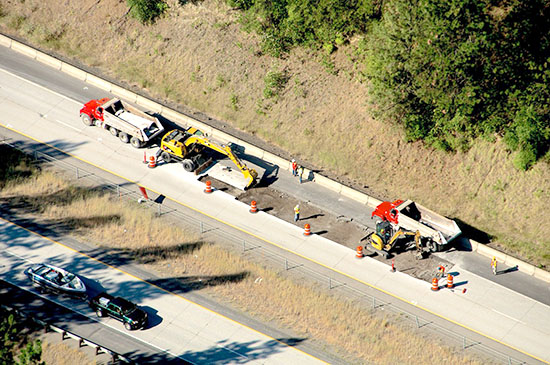|
Subscribe / Renew |
|
|
Contact Us |
|
| ► Subscribe to our Free Weekly Newsletter | |
| home | Welcome, sign in or click here to subscribe. | login |
Construction
| |
 |
May 9, 2017
Public works: Renovations

U.S. 195 PCCP rehab
Location: Spokane
Owner/developer: Washington State Department of Transportation
Team: Wm. Winkler Co., general and concrete contractor; Spokane Rock Products, ready-mix supplier
This Washington Department of Transportation project included rehabilitation of 8.8 miles of the two southbound lanes of U.S. 195 between East Excelsior Road and Interstate 90 in Spokane.
The original 8-inch prestressed concrete cylinder pipe (PCCP) was constructed in phases from 1953 to 1964 and was experiencing severe failures. Minimal maintenance and repair had been performed over the 50-plus years of service life.
Work included removal and replacement of 14,400 square yards of Portland cement concrete panels, including base reconstruction; 4,200 square yards of panel jacking with chemical grout; 112,900 square yards of Portland cement concrete pavement grinding; 214,600 linear feet of joint repair and reconstruction; 29,300 square yards of micro-milling bituminous paving; 2,900 square yards of asphalt shoulder reconstruction and 58,400 square yards of slurry seal; 128,200 linear feet of pavement marking; associated tasks and significant traffic control.
U.S. 195 is the main traffic corridor for southbound traffic from Spokane to Pullman, and it was essential to maintain one lane of traffic throughout the course of construction. The fast-track, 80-day working schedule required multiple phases and types of work to occur simultaneously.
Logistics of removing and transporting existing materials while importing new materials for reconstruction was difficult while maintaining high volumes of traffic through the project area. The topography of the roadway compounded access to and from the project location.
Existing asphalt patches were milled and removed from the concrete road. Approximately 3,250 cubic yards of high early strength concrete was utilized for PCCP panel replacement at numerous locations along the roadway.
Once panels were replaced and others chemically grouted to grade, the entire roadway was ground to strict compliance. Severe wheel-path ruts were ground smooth to adjacent surfaces. At the same time, 40.6 miles of pavement joints were reconstructed, including spall repair, cleaning, routing and resealing.
While some of the PCCP time-stamped from 1953 to 1964 were removed, approximately 88 percent of the existing PCCP was rehabilitated for additional service life well beyond the current 50-plus years of operation. This project is a testament to the sustainability of concrete pavements, exemplifying the advantage of life-cycle costs.
Other Stories:
- Grand Award
Public works: Bridges - Special applications: Resiliency
- Community Award
- Concrete paving
- Pervious concrete
- Artistic and decorative concrete
- Residential concrete
- Public Works: Infrastructure
Sustainable Merit - Cast-in-place structures
- Cast-in-place structures: Parking garage
Special applications: Technical merit (tie) - Tilt-up structures
- Special applications: Technical merit (tie)


